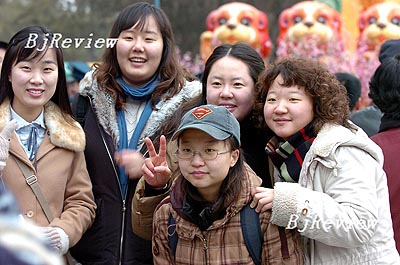
Whenever South Koreans come to Wangjing, a major residential area in Chaoyang District of northeast Beijing, they immediately feel at home. Korean tablets and signs are everywhere, Korean restaurants dot street blocks and Korean products are sold in supermarkets. Even staffers at local apartment-renting agencies speak basic Korean.
With trade and economic cooperation between China and South Korea increasing annually, more and more South Koreans are heading to China to reap the benefits.
More than 700,000 South Koreans live in China, with about 100,000 in the capital, according to statistics from the South Korean Embassy in Beijing. Except for 57,000 students, all are business people and their families.
About 60,000 South Koreans live in Wangjing, making it the largest South Korean village in Beijing, according to statistics from the magazine Southern Weekend. While most South Koreans settle in Wangjing, others have formed smaller communities in Beijing. Wealthy South Koreans live in villas in Shunyi District close to international schools where they send their children. Students live in Wudaokou near the Beijing Language and Culture University where they study Chinese.
There are also about 100,000 South Koreans in Qingdao in Shandong Province and 50,000 in Shanghai.
Nowadays, at least 100,000 South Koreans come to live in China every year. The number of South Korean immigrants is expected to reach 1 million in 2008.
China attracts so many South Koreans mainly because they find life here to be much easier than in their own country, and job opportunities are plentiful.
Wangjing is home to the headquarters of more than 300 hi-tech companies in China, including the offices of many South Korean companies such as LG Electronics Inc., according to a report in the newspaper Economic Observer. These companies usually provide apartments for their South Korean employees and their families. Compared to their colleagues back home, these employees work fewer hours, receive higher salaries and are generally treated better.
They also pay less for food and other necessities here than they would in Seoul. The price of agricultural products, for example, is about 10 times higher in the South Korean capital than in Beijing. The average price of an apartment in Seoul was about 35,300 yuan per square meters in August 2006, almost three to four times the cost of one in Beijing at that time. It is reported that South Koreans have purchased about 40 percent of the apartments in Wangjing.
South Koreans come to China because they believe they can prosper here as the country’s economy continues to boom. With the success of the Olympic Games in Seoul in 1988, they believe that the 2008 Olympic Games in Beijing will present more job opportunities for them.
Although South Koreans continue to come to China in droves, they face some difficulties. The first is language. Because Korean is widely spoken in South Korean communities in China, the immigrants are not eager to learn Chinese. This prevents them from communicating with people outside their communities here.
Many South Korean families living in China also send their children back to their homeland for schooling, because the country’s primary education is free. But in doing so, their children usually do not receive the compulsory nine-year education that they would in China’s educational system.
South Korean immigrants also don’t receive adequate medical care in China. They rarely go to hospitals outside their communities, because of the language gap and because many do not have medical insurance.
In spite of these barriers, South Koreans have made their mark on Chinese society. In recent years, Korean foods and fashions have become very trendy among the Chinese. In Wangjing, many real estate companies have started building apartments suited specifically to South Koreans with floor heating devices, brighter wall colors and more wooden decorations. These apartments have been such a hit that now the Chinese want to buy them. | 